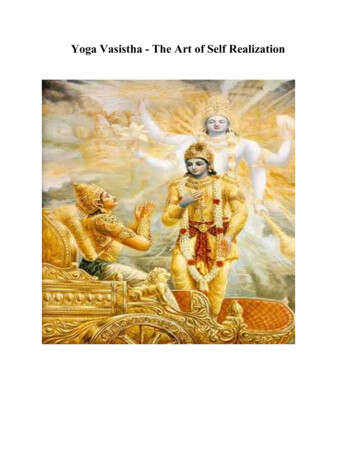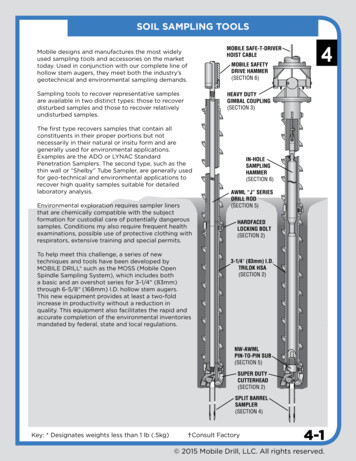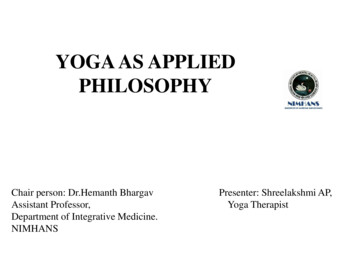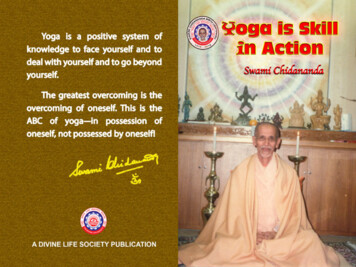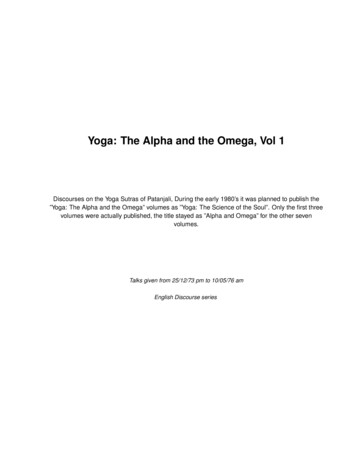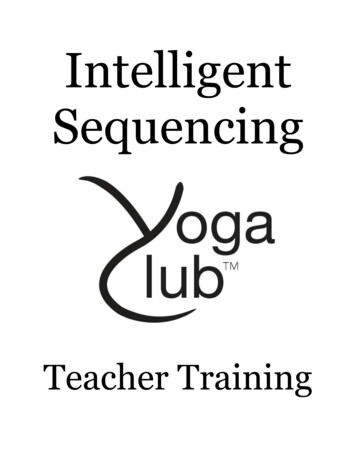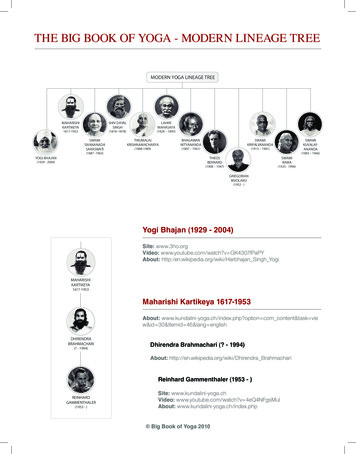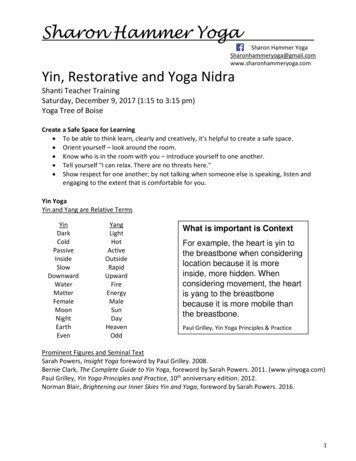
Transcription
Sharon Hammer YogaSharon Hammer .comYin, Restorative and Yoga NidraShanti Teacher TrainingSaturday, December 9, 2017 (1:15 to 3:15 pm)Yoga Tree of BoiseCreate a Safe Space for Learning To be able to think learn, clearly and creatively, it’s helpful to create a safe space. Orient yourself – look around the room. Know who is in the room with you – introduce yourself to one another. Tell yourself "I can relax. There are no threats here." Show respect for one another; by not talking when someone else is speaking, listen andengaging to the extent that is comfortable for you.Yin YogaYin and Yang are Relative eRapidUpwardFireEnergyMaleSunDayHeavenOddWhat is important is ContextFor example, the heart is yin tothe breastbone when consideringlocation because it is moreinside, more hidden. Whenconsidering movement, the heartis yang to the breastbonebecause it is more mobile thanthe breastbone.Paul Grilley, Yin Yoga Principles & PracticeProminent Figures and Seminal TextSarah Powers, Insight Yoga foreword by Paul Grilley. 2008.Bernie Clark, The Complete Guide to Yin Yoga, foreword by Sarah Powers. 2011. (www.yinyoga.com)Paul Grilley, Yin Yoga Principles and Practice, 10th anniversary edition. 2012.Norman Blair, Brightening our Inner Skies Yin and Yoga, foreword by Sarah Powers. 2016.1
Yin and Yang TissueMuscles are generally yang because they are softer andmore elastic than connective tissue such as tendons andligaments which are generally yin because they tend tobe stiffer and more inelastic or plastic.Sarah Powers coined thephrase "yin yoga" todifferentiate between whathad become popular as avinyasa style flow yoga froma softer gentler style ofyoga.A yin practice is not an attempt to stretch theconnective tissue but holding the poses loads thetissues. The stress in the tissues initiates the body'snatural response to stress which stimulates circulation.Circulation promotes healthy tissue whether it is yang oryin tissue.Three Tenets of Yin Yoga Poses1. To come into the shape to an appropriate edge. Non-aggressively with sensitivity. Not too much but enough tension.2. To become still and muscularly soft. Allow gravity to work its magic. Adjust; if you went too far or if you can go deeper.3. To hold the poses for 3 -5 minutes. Allow the joints, connective tissues and energy lines in the body to be fully nourished. Notice what arises emotionally and mentally; the response to the discomfort.Note: Yin yoga, as presented here, is NOT Restorative yogaYin Poses (Same as yang poses with different names)1. Anahatasana (aka Melting Heart)2. Bananasana3. Butterfly4. Half butterfly5. Camel6. Cat pulling its Tail7. Caterpillar8. Child's Pose9. Dragons10. FrogYin Sequences for Organ HealthSarah Powers - Meridian Theory Kidneys and bladder Liver and gallbladder Spleen and stomach11. Happy Baby12. Reclining Twists13. Saddle14. Shavasana15. Shoelace16. Snail17. Sphinx and Seal18. Square23.Straddle (aka Dragonfly)19. Swan & Sleeping Swan Lungs and large intestineHeart and small intestine2
Restorative YogaRestorative yoga seeks to achieve physical, mental, emotional and energetic relaxation. Primarily afloor-based practice using props to support the postures and allowing the body to activate theparasympathetic “rest and digest” portion of the autonomic nervous system.Authors and TextJudith Lasater, Relax and Renew, Restful Yoga for Stressful TimesSue Flamm, Restorative Yoga with AssistsBenefits of a Restorative Yoga Practice Reduces cortisol, the stress hormone Lowers blood pressure and heart rate Reduces muscle tension & insomnia Boosts immunity Reduces serum triglycerides and blood sugar levels Increases “good” cholesterol, Improves digestion and elimination Increases capacity to regulate blood glucose levels Lessens or alleviates chronic, severe pain Enhances fertility Increases blood flow to the heart Stimulates flow of the lymphatic system:o The lymphatic system is a network of tissues andorgans that help rid the body of toxins, waste andother unwanted materials. The primary function ofthe lymphatic system is to transport lymph, a fluidcontaining infection-fighting white blood cells,throughout the body. Increases oxygen levels in the blood Cultivates greater patience with yourself and othersLymphatic SystemUtube Channel “Crash Course”These videos on the science of the body describe functions of the body.Autonomic Nervous System: https://www.youtube.com/watch?v 71pCilo8k4MParasympathetic nervous system, structural differences from the sympathetic system, the twelvecranial nerves and the vagus nerve. https://www.youtube.com/watch?v qqU-VjqjczE.Sympathetic Nervous System: https://www.youtube.com/watch?v 0IDgBlCHVsA&t 48sStephanie Shorter, The Vagus Nerve as a Mind-Body Connection, Yoga Therapy Today, Summer 2014.International Association of Yoga Therapist (www.iayt.org)How Restorative Yoga Works1. Creating a completely supportive environment, being floor-based and using props helpsstudents relax.2. Restorative sequences designed to move the spine in all direction (flexion, extension, rotationand laterally) creates spinal health. “Healthy spine, healthy life.”3
3. Gentle inversions encourage the reverse flow of blood and lymph fluid and oxygen to the upperbody.4. Forward folds stimulate and soothe the internal organs of the abdominal area. For example, aforward fold compresses the internal organs and upon the release fluid and blood rush back inwhich increases circulation, increasing circulation promotes healthy tissue.5. Twists increase spinal flexibility and massages the internal organs.6. Encourages the balancing of Prana, which resides in upper body and moves upward, and Apana,which resides in the lower body and moves downward.Restorative Yoga Poses1. Supta Baddha Konasana2. Side lying twist (each direction)3. Supported forward fold4. Legs up the wall5. Lying over a bolster on the side (each side)6. Legs over a bolster supported on blocks7. Supported child’s pose8. Supported bridge poseSitting and standing causes the body’sfluids to pool in the lower half of thebody. Legs up the wall reverses the pullof gravity for the body’s fluids andstimulates the lymph system. Getting theheart above the head increases oxygento the head.Yoga NidraYoga Nidra is an ancient meditative practice with origins in the Vedic scriptures ,the oldest scriptureson Hinduism. It is a powerful and unique state of awareness in which the body profoundly relaxes, thethinking mind fades away, emotions seem to evaporate, alertness magnifies, and awareness becomescrisp and clear. Julie Lusk, Yoga Nidra for Complete Relaxation & Stress ReliefAuthors and Texts*Swami Satyananda Saraswati, Yoga Nidra (Especially recommended) He developed what we nowknow as yoga nidra.Julie Lusk, Yoga Nidra for Complete Relaxation & Stress Relief.Richard Miller, Yoga Nidra A Meditative Practice for Deep Relaxation and Healing.Billy Doyle, Yoga in the Kashmir Tradition: the art of listening – A book on the art of listening.Yoga NidraYoga Nidra is two Sanskrit words, Yoga meaning union or one-pointed awareness and nidra meanssleep. It is systematic method of inducing complete physical, mental and emotional relaxation. Duringthe practice the person may appear to be asleep, but the consciousness is functioning at a deeper levelof awareness.Yoga nidra is sleepThreefold Tensions are Progressively Released:with a trace ofSwami Satyananda Saraswati, Yoga Nidraawareness1. Muscular tensions related to the body, the nervous system andendocrinal imbalances.2. Emotional tensions which come from dualities such as love & hate, profit & loss, success & failure,etc. that we do not release through sleep.3. Mental tensions which result from our mental activity and life experiences also, not releasedthrough sleep.4
The 8 Limbs of Yoga as described by the Sage PatanjaliThe first 4 are preparatory or external stages of the conscious mind. This is the rational, analytical partof consciousness which is active in the normal waking state. YAMA - Restraints, moral disciplines or moral vows NIYAMA - Positive duties or observances ASANA – Posture PRANAYAMA - Breathing techniquesThe last 4 are higher external stages which involve the subconscious mind. PRATYAHARA - Sense withdrawal DHARANA - Focused concentration DHYANA - Meditative absorption SAMADHI - Bliss or enlightenmentYoga Nidra is a technique to practice pratyahara; to redirect sensory awareness from an external focusto an internal one. Awareness is progressively withdrawn from the external world, the body, theprocess of breathing, the conscious mind, and finally, the unconscious mind. The mind graduallybecomes one-pointed. It is not a practice of concentration. If you concentrate you will obstruct thenatural flow of awareness. Awareness is maintained by focusing on the auditory channel. Whenconsciousness is operating through only one sensory channel (here the auditory channel, hearing) itbecomes far more sensitive.Benefits of Yoga Nidra Activates the relaxation response and deactives the body's stress response. Increases immunity and the ability to fight germs and infections. Improves heart functioning by lowering blood pressure. Decreases pain. Improves symptoms associated with diabetes. Reduces insomnia and improves sleep. Increases energy. Reduces worry and enhances clear thinking. Develops intuitive creativity.A physical yoga practice without the practice of quieting the mind and withdrawing the senses is like aone-winged bird. Julie LuskOutline of the Practice Last between 20-40 minutes. Important to not fall asleep because you lose the awarenessthat you are working toward. Usually, in Shavasana, palms turned upwards. Sankalpa or resolve – ie: “I am” statement. Rotation of consciousness. Awareness of the breath. Feeling and sensations- practicing opposites of feelings.Homunculus5
Visualization – relaxes the mind.Ending the practice – restating the resolve. It is a message from the unconscious to theconscious mind.Other Types of Sub/Un conscious WorkiRest Yoga Nidra is a contemporary version of yoga nidra. Developed by Richard Miller initially for useof the military in working with PTSD. Since iRest was developed in the early 1970s, it has been studiedand used and shown to be effective in treating many types of emotional and mental afflictionsincluding trauma. iRest is copywritten and trademarked and you must be certified through the iRestInstitute to say you teach iRest. www.irest.comLucid dreaming is a dream where the dreamer is aware of dreaming. During lucid dreaming, thedreamer may be able to exert some degree of control over the dream characters, narrative, andenvironment. Andrew Holecek, Dream Yoga, 2016.Hypnosis is a state of heightened relaxation where the person is led into a deep sleep where the mindis shut down. Different from yoga nidra, the consciousness is confined to a small area of the brain andthe capacities for relaxation are limited.TeachingCreate the Environment As the teacher, take responsibility for creating the environment in the room. Make room forstudents as they arrive, especially new students and greet students. Create the safe space - encourage students to orient themselves to their surrounding andfacilitate a sense of safety. Remind students to take care of themselves; that they do not need permission. Be mindful of the tone of your voice - especially in a meditative practice like yin, restorative andyoga nidra. A soothing tone can help students relax. Teach what you know and are comfortable teaching.The Class Allow students to arrive and transition into the practice. Begin with turning the focus inward, aminute of silence and stillness. Viniyoga is a gentle transition moving the body with the breath and begin focusing the mind. Limit the number of poses for the class to 4 - 6. As you move from one pose to anotherencourage students to move mindfully and continue to cultivate the meditative state. Sample cues for relaxation:o Bring the focus of your attention to the breath; follow your breath cycle.o Imagine your mind as a big blue sky; like clouds, thoughts drift by.o Let go of thinking and notice the felt sense in the body.o You have no place to go and nothing to do.o Sink into your bones; feel the weight of your body.o Surrender into the shape.o Inhale something you need; courage, kindness, love, forgiveness.o Exhale something you don't need; regret, worry, fear, judgment.6
The Breath is Central to all these PracticesSwami Saradananda, The Power of the BreathCreativityWhat does creativity have to do with Teaching Yoga? If you teach a lot, you will need to findsome creativity to keep both you and your students interested.Blocks to Creativity6. That’s not my job1. Trying to find the “right” answer7. Being a “serious” person2. Logical thinking8. Avoiding ambiguity3. Following the rules9. Being wrong is bad4. Being practical10. I’m not creative5. Thinking that play is not workWays to Stimulate Creativity1. Keep a notebook and pen handy to jot down ideas.2. Daydream to use your imagination.3. Do not compare yourself to others. This is a quick creativity killer.4. Stop doubting your ability.5. Listen to music. It stimulates a different part of the brain.6. Look at something blue or green. These colors tend to enhance performance on cognitive tasks.Researchers say that’s because we associate blue with the ocean, sky, and openness in general,while green signals growth.7. Laugh it stimulates the brain.8. Exercise the eyes. Moving the eyes back and forth facilitates interaction between the right andleft hemispheres of the brain, which can boost creative thinking.9. Do some yoga; relieves stress and too much stress is a creativity killer.7
Sarah Powers, Insight Yoga foreword by Paul Grilley. 2008. Bernie Clark, The Complete Guide to Yin Yoga, foreword by Sarah Powers. 2011. (www.yinyoga.com) Paul Grilley, Yin Yoga Principles and Practice, 10th anniversary edition. 2012. Norman Blair, Brightening our Inner Skies Yin and Yoga,


